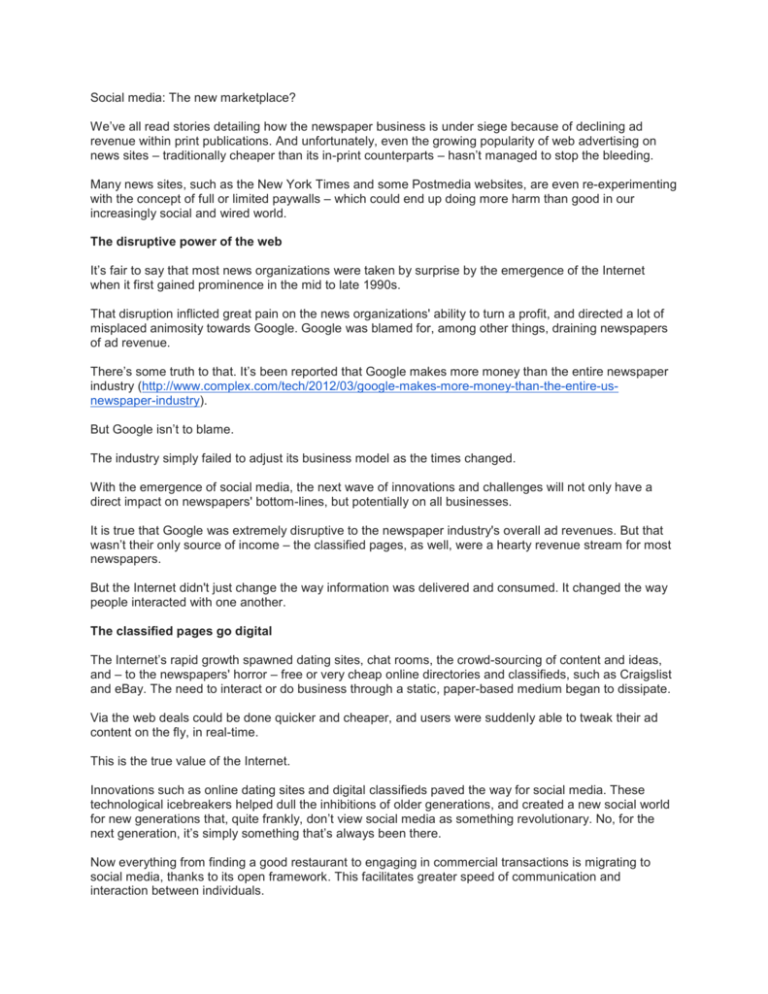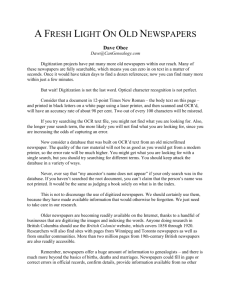Brett - social media
advertisement

Social media: The new marketplace? We’ve all read stories detailing how the newspaper business is under siege because of declining ad revenue within print publications. And unfortunately, even the growing popularity of web advertising on news sites – traditionally cheaper than its in-print counterparts – hasn’t managed to stop the bleeding. Many news sites, such as the New York Times and some Postmedia websites, are even re-experimenting with the concept of full or limited paywalls – which could end up doing more harm than good in our increasingly social and wired world. The disruptive power of the web It’s fair to say that most news organizations were taken by surprise by the emergence of the Internet when it first gained prominence in the mid to late 1990s. That disruption inflicted great pain on the news organizations' ability to turn a profit, and directed a lot of misplaced animosity towards Google. Google was blamed for, among other things, draining newspapers of ad revenue. There’s some truth to that. It’s been reported that Google makes more money than the entire newspaper industry (http://www.complex.com/tech/2012/03/google-makes-more-money-than-the-entire-usnewspaper-industry). But Google isn’t to blame. The industry simply failed to adjust its business model as the times changed. With the emergence of social media, the next wave of innovations and challenges will not only have a direct impact on newspapers' bottom-lines, but potentially on all businesses. It is true that Google was extremely disruptive to the newspaper industry's overall ad revenues. But that wasn’t their only source of income – the classified pages, as well, were a hearty revenue stream for most newspapers. But the Internet didn't just change the way information was delivered and consumed. It changed the way people interacted with one another. The classified pages go digital The Internet’s rapid growth spawned dating sites, chat rooms, the crowd-sourcing of content and ideas, and – to the newspapers' horror – free or very cheap online directories and classifieds, such as Craigslist and eBay. The need to interact or do business through a static, paper-based medium began to dissipate. Via the web deals could be done quicker and cheaper, and users were suddenly able to tweak their ad content on the fly, in real-time. This is the true value of the Internet. Innovations such as online dating sites and digital classifieds paved the way for social media. These technological icebreakers helped dull the inhibitions of older generations, and created a new social world for new generations that, quite frankly, don’t view social media as something revolutionary. No, for the next generation, it’s simply something that’s always been there. Now everything from finding a good restaurant to engaging in commercial transactions is migrating to social media, thanks to its open framework. This facilitates greater speed of communication and interaction between individuals. And that’s the takeaway from the experience of the newspapers in the 1990s and beyond. Instead of fighting it, businesses of all types must now embrace social media as a way to generate leads, engage current and future customers, and market themselves in innovative ways. Not only is the commercialization of social media happening right now, but when companies engage and listen to social chatter, they are able to be proactive by addressing issues as they appear – such as a steak restaurant responding to a tweet asking where to find a good steak in their area – and, in turn, better serve the public.











